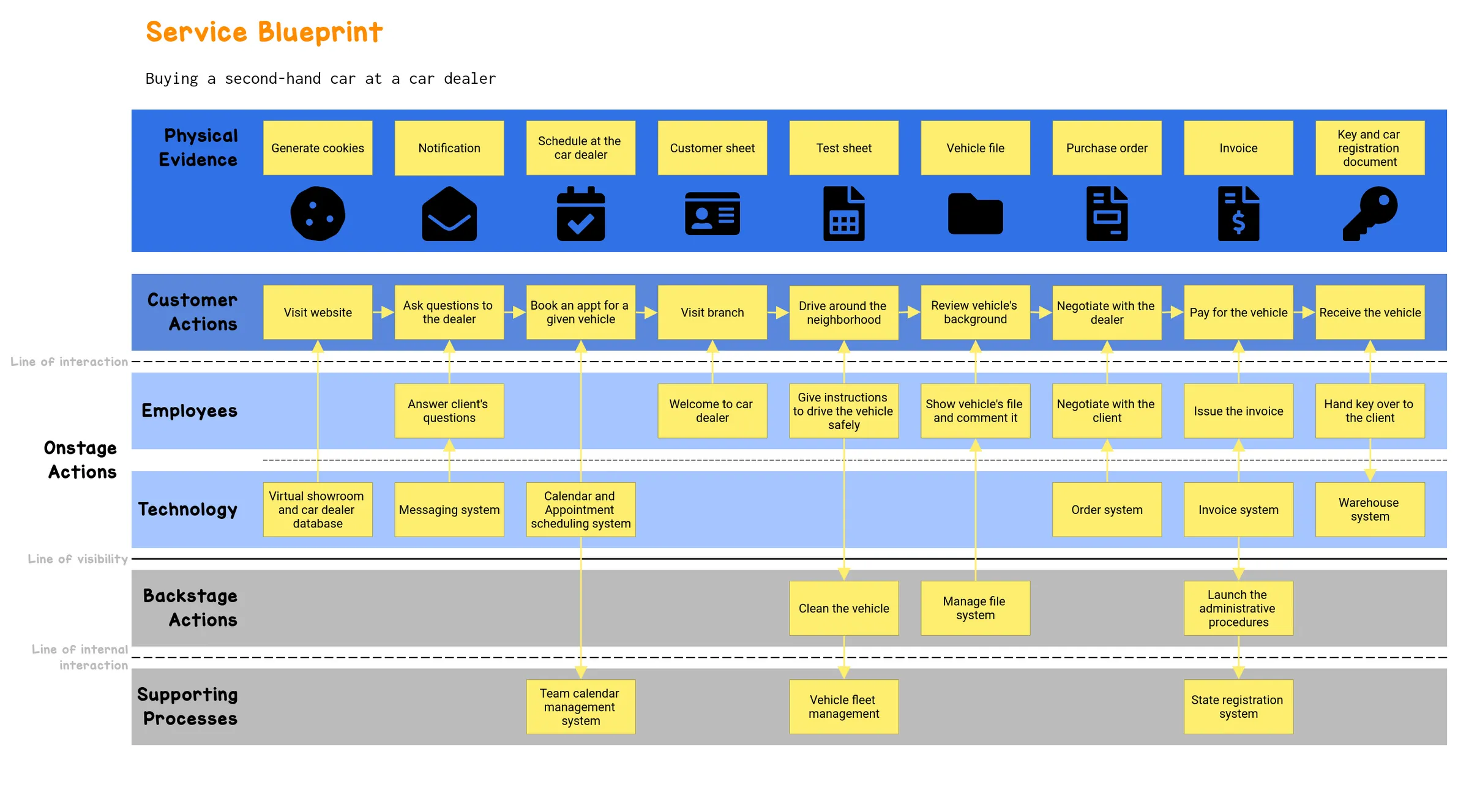Service Blueprint

What is a Service Blueprint?
The Service Blueprint is a Service Design method that consists in mapping the journey of a customer who accesses a service through the prism of its components — either physical or digital artifacts, human resources, or processes — that the organization must operate to provide this service to this customer at each step of its journey.
This method is particularly useful when a customer experience is either multi-channel, characterized by multiple interactions at each stage of the journey, or involves coordinated actions by the organization providing the service.
Highlighting the components that are not visible to customers, the Service Blueprint helps, on the one hand, to identify exhaustively the operational levers likely to contribute to the improvement of the service and, on the other hand, to establish the relevant performance indicators.
How to build a Service Blueprint?
Building a Service Blueprint goes through 5 different stages, some that occur in the customer’s view and some that occur in the background.
-
1. Define customer actions
Like Customer Journey Mapping, the starting point and skeleton of the Service Blueprint is the journey of the customer who accesses the service. In this first step, the goal is to detail the different actions that the customer must take to achieve its goals.
-
2. Identify the actions that take place in front of the customer (“onstage actions”)
Once the customer’s actions have been described, you must identify with whom and/or what the customer interacts and how these elements contribute to the customer experience at a specific step. This can be a website, an application, an employee, a touch terminal, etc. These are the visible elements of the process from the customer’s point of view.
-
To bring an additional level of detail to the Service Blueprint, you can distinguish human interactions, which can involve one or more employees, from human-machine interactions, which generally involve a platform (application, website, etc.) or an autonomous terminal.
-
3. Identify the actions that take place “behind the scenes” (“backstage actions”)
Backstage actions are actions that do not occur in the customer’s sight, for example, a cook who prepares a meal for a customer in the kitchen of a restaurant. Note that these actions can be undertaken by an employee who directly interacts with the customer; the only distinguishing criterion is the visibility of these actions by the customer.
-
4. Identify the processes that enable the service to be provided (“supporting processes”)
At this step, you should list everything that must indirectly happen within the organization to provide the service to the customer at a given point. This can be a procedure to follow, something to prepare upstream, or any other organization component that must be indirectly operated to provide the service.
-
5. List the artifacts and places involved in each step (“evidence”)
To bring context to the actions that take place during the process, the Service Blueprint methodology requires the collection of pieces of “evidence” of the interactions, for example, places, physical or digital artifacts, documents, etc.
To leverage further Service Blueprint
Once the Service Blueprint has been completed, additional information can be added to better identify potential problems or, on the contrary, opportunities for improvement. Among which we generally find:
- Time to identify possible bottlenecks in the flows and, therefore, better size the resources;
- Regulations/constraints to point out the elements that cannot be modified in the process;
- Emotions to depict the possible frustrations that some employees may experience at certain stages of the journey;
- Indicators to measure the performance of the process.
Some advice and tips from an experienced Agile Coach
Yohan Varona, an Agile Coach at Klanik, shares here some tips to help you get the most out of the Service Blueprint design exercise:
- Get out of the building and go to the field. Service Blueprint shouldn’t be a virtual exercise;
- Take all the time necessary to carry out this complex exercise;
- Be rigorous in naming the components you map, in particular concerning the “physical evidence”;
- Feel free to do several writing sessions to adjust the granularity of the actions described: neither too detailed nor too general;
- Return to the field to challenge your deliverable.
Some suggested resources to learn more about the Service Blueprint
- G. Lynn Shostack’s article that introduced the Service Blueprint: Designing Services That Deliver
- A detailed article by Nielsen Norman Group: Service Blueprints: Definition